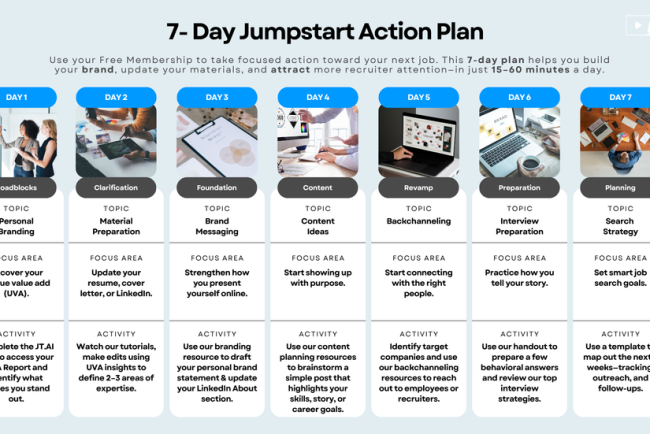
by Admin
Maximize Your Job Search In 7 Days: How Our Premium Membership Sets You Up For Success
Job hunting can feel overwhelming, especially when you’re doing it alone (or receiving unsolicited, unhelpful advice from out-of-touch family members). Between resumes, interviews, and countless applications, it’s easy to feel stuck or unsure about where to focus your time. That’s why our 7-Day Action Plan […]
Career development
by Admin
Unlock Your Career Growth In Just 7 Days: How To Maximize Your Work It DAILY Premium Membership
What if you could make real progress in your career…in just one week? At Work It DAILY, we know that the key to career growth is small, sustainable habits. Seven days of consistent effort might just be what you need to start growing your career. […]
Career development
by Admin
How To Answer 7 Of The Most Common Interview Questions
Job interview questions are not always as straightforward as they seem. Even one misstep in how you answer can hurt your chances of landing the position. Interviewers are looking for more than just the “right” answer from a “nice-to-have” candidate. They’re assessing your personality, aptitude, […]
Career development


5 Things To Ask In A Job Interview
by Admin
“Do you have any questions for me?” This is typically the final question you will be asked in a job interview. Ask the wrong questions, and you might look like a bad fit. Ask no questions, and you might look indifferent, inexperienced, or uneducated about […]
Career development
“Do you have any questions for me?”
This is typically the final question you will be asked in a job interview. Ask the wrong questions, and you might look like a bad fit. Ask no questions, and you might look indifferent, inexperienced, or uneducated about the position.
Asking the right questions—aside from proving yourself to the hiring manager—is one of your best (and last) chances to determine whether the job and company are a good fit for you. Here are five questions to consider asking at the end of your next interview.
Why Is The Position Open?
This is actually an extremely important question that should be asked during every job interview because the answer will provide important insights that, should you get an offer, will play a major role in your decision to take the job.
Jobs open up for a variety of reasons—some positive, some negative. Was the job created because the company is expanding? Was the previous person promoted? Or did they quit or get fired? Are you replacing a high performer or a poor one?
The employer’s answer will help you determine whether the job has room for growth or a high turnover rate—and give you a better idea of how to manage expectations.
What Is A Typical Day Like For This Position?

Most job postings list the position’s responsibilities without saying how much time is allocated to each responsibility. You want to know this information for two reasons.
First, if your typical workday includes spending hours doing something you dislike, you may want to reconsider whether it’s the right job for you. Second, by discovering which job functions are most important to the employer, you can tailor the remainder of your interview to those areas and include them in your interview follow-up email.
How Would You Describe The Company Culture?

It’s always good to get a sense of a company’s culture and whether you fit into it. The employer’s response to this question will help you understand what it’s like working there day to day, what the company values are, how colleagues interact with one another, and so on.
Another good way to get a sense of company culture is to ask this question:
Can you tell me about one of your most successful employees and what makes them successful?
If the answer highlights an employee who constantly takes on extra work and regularly exceeds 40 hours a week, this could be a red flag that the company prioritizes long hours over work-life balance. Instead, look for a response that reflects a well-rounded definition of success—one that includes hard work, creativity, collaboration, and problem-solving skills.
Pay attention to whether they mention qualities like leadership, adaptability, or a commitment to company values, as these can indicate a culture that supports professional growth and employee well-being. The way they describe success can give you insight into what the company truly values and whether it aligns with your own career goals.
If you’re going to spend the majority of your waking hours on the job, you should make sure the company culture is a good fit.
What Are The Company’s Goals Over The Next Five Years?

Actually, a more specific question you could ask is:
What are the goals of the company over the next five years? How does this position and this department factor into those goals?
This question demonstrates your goal-oriented nature and suggests that you won’t job-hop right away. It also signals that you’re thinking strategically about your role and how you can contribute to the company’s success. An informed response will give you insight into the organizational structure, leadership priorities, and potential growth opportunities within the company. It can also help you determine whether your professional aspirations align with the company’s vision.
Conversely, an uninformed response suggests the hiring manager is out of touch with the organization, the company does a poor job communicating its goals to employees, or leadership is not thinking long term. None of these are a good sign and could indicate instability or a lack of direction within the company.
Here’s another way to ask this question:
What is the company’s biggest challenge in the coming years, and how does this position help you overcome it?
Do You Like Working Here?

It’s unlikely the hiring manager will say “no,” but you can still infer a lot from their response. A moment’s hesitation followed only by, “Yeah…I do,” might be a red flag. A smile and explanation of why they like working there, on the other hand, signifies a more genuine response.
A few other ways to ask this question include:
How did you come to work here?
What do you like most about working here?
If you interview with multiple employees during your job interview, ask each of them similar questions. This is particularly helpful when it comes to subjective questions (e.g., “How would you describe the company culture?” and “Do you like working here?”). Doing so will help you paint a more complete picture of the organization, which will help you make the best decision once you’re offered the job.
Need more help preparing for your next job interview?
Get access to our Free Resource Center today (no credit card required!).

by Admin
Trip to Maynooth
I’m horribly behind on sharing my stuff on this blog. My plan is always to share everything that that I do that might be of use to other people via this site. Once in a while there is something that I can’t share for some […]
PresentationsI’m horribly behind on sharing my stuff on this blog. My plan is always to share everything that that I do that might be of use to other people via this site. Once in a while there is something that I can’t share for some reason, but everything else it thrown up here. Most of it is probably of limited interest, but it is here in case you find it interesting. But, recently a general business has overwhelmed me and I haven’t managed to keep up.
Anyway… a few weeks ago I had an amazing trip to Maynooth in Ireland to talk about career guidance policy and social justice. The University is lovely and the community that they have set up around the guidance courses is truly inspiring. It was an honour to visit.
While I was there I gave two talks. The first one focused on adult guidance policy and was mainly aimed at policy actors. It hopefully provided some ideas for the Irish guidance community, building on some of the work that I’ve been doing in England and elsewhere. This is what I covered.
The second was a workshop in which we looked at social justice and critical approaches to guidance.
Hopefully some of this will be of interest and thanks again to Maynooth for hosting me.

by Admin
Spring Cleaning: 4 Ways To Fix Your Job Search
Is your job search turning into a grind with no end in sight? It may be time to take a step back and reevaluate your entire approach. In cold weather climates, the beginning of spring is a time to clean the house and get organized—a […]
Career development
Is your job search turning into a grind with no end in sight? It may be time to take a step back and reevaluate your entire approach.
In cold weather climates, the beginning of spring is a time to clean the house and get organized—a practice known as spring cleaning. Through the years, spring cleaning has taken on a larger meaning, with people using the time to organize and declutter things in their lives.
For professionals on the job hunt, a little spring cleaning (metaphorically speaking) could be a great way to reinvigorate your job search. Here are a few strategies your job search spring cleaning should include…
Reevaluate Your Job Search Approach
Make a list of the last handful of jobs you applied for and see if you can identify any positive or negative trends. Consider things like:
- How did I learn about this job?
- How did I apply for the job?
- Did I earn an interview?
- What was the ultimate result?
A lot can be learned about your job search approach just by answering these questions and identifying patterns. For example:
Negative Trends
You discovered five jobs through job boards, applied to all of them via the job boards, and never heard back from any of them.
The common pattern here is applying through job boards. This isn’t to say that job boards don’t serve a purpose in the job search process, but they have their limitations, and you can’t run your job search entirely off of them.
When you apply through a job board, there’s a good chance that your resume will never get past the applicant tracking system (ATS) and never be seen by an actual person.
One simple fix is to research who the hiring manager is that posted the position, address your cover letter to them directly, and apply for the job directly on the company’s website.
The more efficient fix would be to take a proactive approach by putting together a bucket list of companies that you want to work for and start making connections on LinkedIn with people who work at those companies. You may already know some people who work there or have connections that can refer you to some individuals.
This strategy is called backchanneling, and it’s the best way to network your way onto a company’s radar and stand out to hiring managers.
Positive Trends
You applied for three jobs via referral, were invited to two job interviews, and made it through multiple rounds of interviews for one of the jobs before being passed over for someone with a little more experience.
The pattern here is that getting referred to a job by a professional acquaintance is a great way to land a job interview. This indicates that you’re leveraging your network well, and you should continue to focus on your networking efforts.
The next step is to review the interview process and determine what went well and what needs to be improved. Sometimes the interviewer will provide feedback, and that feedback can be valuable. However, not everyone is comfortable with giving feedback.
Chances are you probably have a good idea about areas of improvement and the skills you need to gain. Put together a plan for addressing those shortfalls.
The good news in making it deep into any interview process is that it indicates that the company likes you as a potential employee (even if the timing just wasn’t right), and the experience could be a roadmap to a job with that company at a later date or another similar opportunity elsewhere.
Give Your Resume & Cover Letter Some Much-Needed Attention

Are you continuously sending similar resumes and cover letters to each job opening with only minor adjustments? If so, your strategy needs some serious spring cleaning.
Let’s start with resumes!
Every resume should be tailored to the position in order for it to stand out to recruiters and hiring managers. It may seem like a lot of work, but it’s actually less work than submitting the same resume over and over again and never hearing back.
The reason why it’s so important to tailor your resume is that throughout your career, you acquire numerous skills, but the job you’re applying for may only be focusing on 6-8 of those skills. In that case, those skills must rise to the top of the resume with quantifiable examples of how you successfully used those skills at previous jobs.
Remember, recruiters go through hundreds of resumes. They need to be able to tell from a quick glance whether or not you’re a potential candidate for the position.
While updating your resume, you could also spruce up your LinkedIn profile by highlighting the skill sets that you want to be noticed for by recruiters.
As for writing a good cover letter, the key to success is a disruptive cover letter. When you write a disruptive cover letter, you’re basically telling a story. The story should focus on how you connect with the particular company and job position. Why are you passionate about this line of work? What do you like about the company’s products or services? Why do you admire the work they do? The story could also focus on your personal journey, and how you got to where you currently are in your career.
If your resumes and cover letters aren’t unique, now is the time to clean things up and get on track.
Build Your Personal Brand

Just because you’re looking for work doesn’t mean that you don’t have anything to offer. Use previous career experiences and passions to build your personal brand.
Ask yourself, “How do I want other professionals to view me?”
Pick an area of expertise and start sharing your knowledge and experience with your professional network by pushing out content on your LinkedIn and social media accounts. Good content can include blogs, social media posts, and videos.
By sharing content about your experiences and passions, you slowly build your personal brand, and others will start to notice. The content could lead to good discussions with others in your network. It could also lead to reconnecting with connections that you haven’t spoken to in years or making new connections.
You never know when one of these connections could turn into a job lead or referral. The trick is to get on people’s radars. So, when you’re cleaning up your job search, be sure to build a plan for personal branding.
Maintain Healthy Habits During Your Job Search

Your job search is important, but it’s even more important to know when to pull back and focus on personal health and spending time with family and friends.
There are actually things that you can do for your own enjoyment that could help your job search in the long run, such as:
- Grab coffee with a friend. It’s good to engage in light conversation with friends during challenging times. And if your job search does come up, remember that most people have been through it themselves and you never know when a friend may provide you with a good idea or lead on a job.
- Volunteer. Volunteering is a great way to get involved in the community and help others. In addition, if you develop a little bit of a career gap while looking for a job, you can always talk about how you filled that time volunteering if you’re asked about it during a job interview.
- Continue to focus on other passions. Are you a fitness nut? Blogger? Crafter? Continue to do the things that bring you happiness. And if you’re in a position to profit from your passion through a freelance job or side hustle, even better!
Spring is the perfect time to clean up and improve your job search so you can land the job you want. If you’re struggling to find a job, follow the tips above to reinvigorate your job search—and watch your career blossom!
Need more help with your job search?
Get access to our Free Resource Center today (no credit card required!).

by Admin
Why White-Collar Professionals Struggle To Get Noticed (And How Pro Voice Can Change That)
As a white-collar professional, do you feel like you’re invisible in your job search? If you’re like most unemployed job seekers right now, you’ve tried “everything” and are still being ignored by recruiters. The truth is that in today’s ultra-competitive job market, talent alone isn’t […]
Career development
As a white-collar professional, do you feel like you’re invisible in your job search? If you’re like most unemployed job seekers right now, you’ve tried “everything” and are still being ignored by recruiters. The truth is that in today’s ultra-competitive job market, talent alone isn’t enough; you need another way to stand out.
Many highly skilled white-collar professionals find themselves stuck in a frustrating cycle—overlooked, undervalued, and unable to break through the noise on LinkedIn. Despite years of experience and deep industry knowledge, they struggle to establish themselves as credible voices.
Instead of attracting job offers, speaking engagements, and career growth opportunities, they watch as others—sometimes with less expertise—dominate the conversation.
The problem isn’t a lack of skill. It’s a lack of visibility.
The Top 5 Problems Keeping Professionals Stuck
If you’re a white-collar professional feeling stuck, chances are you’re facing at least one of these challenges:
1. Fear of Judgment or Feeling “Cringe” About Posting Online
You want to share your insights, but the fear of being judged holds you back. What if people don’t like what you post? What if it comes across the wrong way?
2. Not Knowing What to Say or How to Create Authentic Content
You have knowledge to share, but crafting content that feels natural and engaging seems impossible. Where do you even start?
3. Feeling Invisible or Overlooked Despite Having Experience and Skills
You’ve put in the work, built your expertise, and yet, you’re not being recognized as a thought leader in your industry.
4. Lacking a Consistent and Confident Online Presence
Posting sporadically—or not at all—leaves your LinkedIn profile stagnant. Without consistency, it’s hard to gain traction.
5. Wasting Time on Content That Doesn’t Get Engagement or Build Credibility
You’ve tried posting, but the results are disappointing. Low engagement makes it feel like you’re shouting into the void.
Enter Pro Voice: A Proven System to Build Trust & Credibility

When I saw how many white-collar professionals were struggling to get noticed, I knew I needed to build a program that would teach people how to effectively demonstrate their expertise using video content—the best way to stand out on LinkedIn.
That program is Pro Voice.
Pro Voice, featuring the G.L.O.W. Method, is designed to solve the exact challenges I stated above. This four-step system has already helped hundreds of professionals transform from overlooked to in-demand on LinkedIn. Here’s how:
- Gain Perspective – Learn how your audience truly sees your value so you can position yourself strategically.
- Luminate the Goal – Define your unique brand voice and messaging for maximum impact.
- Own Your Actions – Craft compelling, high-trust content that attracts real engagement.
- Work It DAILY – Implement a sustainable strategy that delivers ongoing results.
Why This Matters More Than Ever

In an era where competition is fierce and job security is uncertain, professionals who position themselves as trusted industry voices gain a massive advantage. They don’t just wait for opportunities; they attract them.
The G.L.O.W. Method outlined in my Pro Voice program is about more than getting likes on LinkedIn. It’s about building lasting credibility that opens doors to:
- Speaking opportunities
- Board invitations
- Media features
- Job offers (without applying online!)
Now is the time to be proactive and learn how to demonstrate your knowledge and expertise as a white-collar professional. Your experience is valuable; are you proving that to recruiters?
Take the First Step: Free Live Webinar
If you’re ready to break free from invisibility and start building a professional brand that gets noticed, don’t miss my free live webinar:
Even if you can’t attend live, you’ll receive a replay.
This is your chance to stop playing small and start leveraging LinkedIn the right way. Your expertise deserves to be seen—let’s make it happen.

by Admin
Job Seekers: Never Do This On Mondays
There is one rule I always tell job seekers to follow in regard to their job search activities. Under no circumstances should you ever do this on a Monday. The rule? Never, and I mean never, call or email an employer on a Monday to […]
Career development
There is one rule I always tell job seekers to follow in regard to their job search activities. Under no circumstances should you ever do this on a Monday.
The rule? Never, and I mean never, call or email an employer on a Monday to check the status of your application or ask where the hiring manager is in the decision-making process for a job.
Why You Should Never Contact Hiring Managers On A Monday

Mondays are the busiest, most stressful days of the week for most professionals, especially hiring managers. They’re catching up on emails, tackling urgent issues, and setting priorities for the days ahead. Even the most cheerful workers struggle to get in the groove on a Monday. And given that 56% of Americans surveyed recently said they would like a new job, it’s safe to say that the majority of people are not in the best mood.
The last thing a hiring manager wants on a Monday is an unsolicited message from a job seeker asking about their application status. Reaching out on a Monday can make you seem impatient or inconsiderate of their workload—neither of which leaves a positive impression.
Adding stress or pressure to a hiring manager’s day is not going to help you. So, as much as you are dying to know where you stand in the hiring process, I would suggest waiting until later in the week for several reasons:
- If the hiring manager hasn’t made any progress, they will not appreciate you reminding them.
- If you are not in the running, they will not be thrilled about having to give you the bad news.
- If they are super busy and plan to address the hiring process later in the week, they will not appreciate you trying to push them to address it sooner.
Ironically, all that can change on a Tuesday when hiring managers are organized for the week and back in the productivity zone. Therefore, instead of following up on a Monday, aim for midweek when they’re more likely to have time to review applications and respond thoughtfully.
Job seekers should spend Mondays researching companies and identifying who they want to network with instead of contacting hiring managers. Save the calls and emails for Tuesdays, and you’ll notice that people will be in better moods and respond to you more positively. You’ll have a much easier time in your job search if you avoid reaching out to hiring managers and recruiters at the very beginning of the workweek. Trust me.
Need more help with your job search?
Get access to our Free Resource Center today (no credit card required!).

by Admin
4 Tips For Writing A Powerful Resume
The first challenge with your resume is getting it into the hands of an actual person. Over the past decade, getting through applicant tracking systems (ATS) by including the right keywords has become the holy grail of job seekers. The palace guards were put in […]
Career development
The first challenge with your resume is getting it into the hands of an actual person.
Over the past decade, getting through applicant tracking systems (ATS) by including the right keywords has become the holy grail of job seekers. The palace guards were put in place so that overloaded hiring managers could keep out the riffraff.
And it was necessary.
Surveys report that more than half of the resumes submitted for any job posting are from completely unqualified candidates.
The ATS is meant to boil down the deluge to an actual candidate pool.
As a job seeker, you should be concerned with and aware of how your resume will make it past the guards.
As a serious professional, you need to take your resume further. Make sure that when it makes it to the hands of an actual person, it will impress and get you to the next step.
Here are four resume tips for accomplishing this goal.
1. Lead With The Results
Look at your resume as if you are the hiring manager. Are you making it clear that you can help the company save or make money? Does this resume help solve the problem that needs solving with this position? Not just the “because Henry quit” problem. The thing that makes this position valuable to the company.
Your resume must show how you are the solution because you’ve done it before. Structure your experience so that each sentence is front-loaded with results. Instead of, “Evaluated current processes and led efforts that restructured operations, leading to a reduction in costs and an increase in revenue,” try “Slashed overhead costs by 20% while simultaneously increasing revenue by 45% by completely overhauling sales processes and operations for optimal efficiency.”
If you think like management, you can pick out what management most cares about and make sure you highlight that in your resume.
2. Quantify Your Accomplishments

In other words, use numbers. By adding figures to your accomplishments, you provide measurable, credible proof of your performance.
For example, “Added $4 million to the bottom line…”
Beyond showing revenue, numbers can help provide context for your results through comparisons.
- “Ranked #1 out of 45 sales reps for top sales performance.”
- “Achieved 95% customer referral rate, a figure 2 times higher than the company average.”
- “Conducted company-wide training for 500 employees.”
This is one of the things a lot of people struggle with, but it is vital. Quantifying your accomplishments solidifies them in the mind of the reader. It turns an abstract statement into a hard fact. It also helps hiring managers quickly grasp the impact of your work.
Instead of saying you “led a team,” specify that you “managed a team of 12 and increased productivity by 30%.” Rather than stating that you “improved customer satisfaction,” highlight that you “boosted customer satisfaction scores from 82% to 96% within a year.”
The more specific you are, the more compelling your resume becomes. Even if you don’t have access to precise numbers, estimates based on past performance can still add credibility. Don’t be afraid to take an educated guess!
3. Use Active Words

Fill your resume with verbs that convey energy and action. Carefully selected verbs also help you create concrete statements that create a visual for the reader. Instead of, “Put in processes that led to a significant reduction in costs,” try “Decreased costs by devising efficient sales process.”
But be careful. Don’t use the same verbs over and over. Do the work and find powerful synonyms. Varying your verbs keeps your resume engaging and dynamic, helping to paint a clearer picture of your accomplishments.
Instead of repeatedly using “managed,” consider alternatives like “orchestrated,” “spearheaded,” or “supervised,” depending on the context. Likewise, rather than always saying “improved,” try “enhanced,” “streamlined,” or “revitalized” to better capture your impact.
Thoughtful word choice demonstrates attention to detail and makes your resume stand out to hiring managers.
4. Trim The Fat From Your Resume

This may be the most important tip for creating a powerful resume that will get read and noticed. The hiring manager or recruiter may have dozens of resumes to review, so make sure yours is easy to get through. Write succinctly, be specific, edit out filler words, and trim the unnecessary detail that doesn’t add to your qualifications for the position.
Review and edit. Then, review and edit again.
Also, pay close attention to formatting, ensuring consistency in font, spacing, and bullet points for a polished, professional look. Having plenty of white space is important! Finally, don’t forget to tailor your resume for each job application, emphasizing the most relevant skills and experiences to align with the job description.
The digital age has brought challenges to the job seeker, but they can be overcome. Spend the time to create a powerful resume. Make sure it gets the attention that it deserves.
Need more help with your job search?
Get access to our Free Resource Center today (no credit card required!).

by Admin
How To Market Yourself In A Job Search: The 7-Word Challenge
If you’re a job seeker, this simple yet powerful exercise will change the way you market yourself to employers. It’s honestly going to blow your mind. Are you ready? Here’s the challenge: Describe the value you provide to employers in just seven words. Think about […]
Career development
If you’re a job seeker, this simple yet powerful exercise will change the way you market yourself to employers. It’s honestly going to blow your mind. Are you ready? Here’s the challenge:
Describe the value you provide to employers in just seven words.
Think about how you save or make a company money, justifying the cost of hiring you and paying you the salary you want and deserve. This could mean you generate revenue, solve problems, or improve processes. Take a moment and write down those seven words before continuing.
Why Most Job Seekers Get This Wrong
If you’re like most people, you probably listed seven words describing what you do—your tasks, skills, or responsibilities. But here’s the problem: that’s not how you effectively market yourself.
This is one of the most common mistakes in job searching and personal branding. You are a business-of-one, and if you focus only on listing your features (skills and tasks), you’re making the same mistake businesses make when they fail to highlight their benefits.
Features vs. Benefits: The Key to Standing Out

People don’t buy features; they buy benefits. The same applies to hiring managers. They want to know how you’ll make their lives easier, solve problems, save or make them money, alleviate pain, or help them grow the business.
For example, as a career coach, I could list my features: resume and cover letter help, LinkedIn optimization, interview prep, and networking guidance. But that doesn’t tell you why I’m valuable. Instead, I should focus on the benefits, keeping them to seven words or fewer:
- I help people land new, better jobs.
- I help people make more money.
- I help people get better job offers.
See the difference? When you shift from listing tasks to articulating value, you go from being a “nice-to-have” candidate to a “must-have” candidate in your job search.
What’s a sign that you’re not effectively translating your features into benefits in conversations? If you’re landing interviews but not receiving offers.
If you’re not getting interviews at all, your resume and LinkedIn profile aren’t demonstrating your value clearly.
Unlock Your UVA (Unique Value Add) for Free

The problem is you were never taught the right way to market yourself as a job seeker. That’s why I worked with AI specialists to create “Unlock Your UVA,” a free interactive tool designed to help you uncover and articulate your workplace strengths.
In under two minutes, this tool analyzes your responses and provides insights into how you create value in the workplace. No more guesswork. No gimmicks. No credit card required.
You can access “Unlock Your UVA” inside my Free Resource Center today.
Remember, there’s nothing wrong with you—you have the talent and skills employers need. You just need to market yourself correctly. Let’s unlock your UVA and transform your job search today!
Good luck! Go get ’em.

by Admin
Quick Tip: Use 'Dear Hiring Team' On Your Cover Letter
You’ve always been told that you shouldn’t write, “To Whom It May Concern,” on your cover letter. But what should you do when you don’t have the name of the hiring manager? Addressing your cover letter properly is crucial. It sets the tone for your […]
Career development
You’ve always been told that you shouldn’t write, “To Whom It May Concern,” on your cover letter. But what should you do when you don’t have the name of the hiring manager?
Addressing your cover letter properly is crucial. It sets the tone for your job application and shows attention to detail. Here’s how you should address your cover letter to ensure it’s professional and personalized.
First, Track Down The Name
Obviously, it’s ideal to use the hiring manager’s name in your cover letter. So, the first thing you should do is try to track down the hiring manager’s name online (i.e., the company website, LinkedIn, etc.).
You can also call the company directly to ask for the name. Simply call up the company and say, “Hi, my name is ____ and I’m applying for a position at your company. Would it be possible for me to get the name of the hiring manager so I can address him or her in my cover letter?”
If All Else Fails, Use ‘Dear Hiring Team’

If the hiring manager’s name is nowhere to be found and the company is unwilling to give you his or her name, you should use “Dear Hiring Team” in your cover letter salutation. By addressing your cover letter to the hiring team, you increase your chances of getting it in front of the right pair of eyes.
This greeting is professional and inclusive and demonstrates your understanding that hiring decisions are often made by multiple people rather than a single individual. It also avoids outdated or overly generic salutations like “To Whom It May Concern,” which can make your cover letter feel impersonal.
Why Can’t You Use Someone Else’s Name?

But what if you know the name of someone else (not involved with hiring) who works at the company? Can you just address it to them instead?
Absolutely not!
“That person may not be the person that’s hiring, and they could easily throw [your cover letter] in the trash,” says J.T. O’Donnell, founder and CEO of Work It DAILY. “You don’t know if they’re going to forward it to the right person or not. You do not want to risk that.”
Using “Dear Hiring Team” ensures your cover letter remains both professional and targeted, even when you don’t have a specific name. While personalizing your salutation is always best, this approach keeps your application polished and respectful. So, if you can’t find the hiring manager’s name, don’t stress. Opt for “Dear Hiring Team” and focus on crafting a compelling disruptive cover letter that highlights your connection story and explains why you’re the best fit for the role.
Need more help with your job search?
Get access to our Free Resource Center today (no credit card required!).

by Admin
Understanding The Job Offer Letter And Package
You’ve made it through the rigorous interview process successfully, and the organization has extended you an offer for employment. Congratulations! This is an exciting milestone, but before you accept, it’s important to carefully review the details of the offer. Beyond the salary, your job offer […]
Career development
You’ve made it through the rigorous interview process successfully, and the organization has extended you an offer for employment. Congratulations! This is an exciting milestone, but before you accept, it’s important to carefully review the details of the offer.
Beyond the salary, your job offer letter outlines key terms of employment, including benefits, responsibilities, and potential contingencies. Understanding each component will help you make an informed decision and ensure the role aligns with your expectations and career goals.
Here are some tips for reviewing your job offer letter:
Compensation

The offer letter should include information about how you will be paid. This may state the frequency of paychecks, whether you will be paid hourly or on a salary basis, and whether you will be eligible for commission or bonus payments. In most cases, your compensation will be stated before taxes, so your take-home pay may differ greatly from what is stated in the offer. If you need help determining how much you will be bringing home in each paycheck, you may want to consult an accountant or ask your HR representative to help you with the calculations.
For commission-based positions, it’s wise to ask about draws and how often commission checks are issued. Some companies only pay commissions one time per month, so it’s important to know this information up front for budgeting purposes.
In addition to understanding your base pay and commission structure, be sure to review any details about overtime eligibility, pay differentials for working nights or weekends, and potential salary increases over time. Some companies also include signing bonuses, relocation assistance, or stock options in their offer packages, so it’s important to clarify when and how these payments will be made. If you’re offered equity or stock options, take the time to understand vesting schedules and tax implications.
Lastly, ensure you are clear on any deductions that may come out of your paycheck, such as benefits contributions, retirement plan deductions, or union dues, so you can accurately estimate your net income.
Details About The Job

A job is much more than just a title, so many companies include information about daily responsibilities or provide a job description.
You should understand the schedule for the job and what will be expected of you, including any potential overtime, travel requirements, or flexibility in work hours. If this information isn’t included, ask the hiring manager for a copy of the job description. This doesn’t mean that it’s written in stone and you will only be required to do those tasks listed, but it serves as a foundation for understanding your role.
Additionally, reviewing the job description can help you identify any gaps between your expectations and the company’s, allowing you to address concerns before accepting the offer.
Benefits

If your position is full time, it’s likely that you will be offered some type of benefits package by the employer. You should pay careful attention to what is included because these benefits can add significant value to the overall compensation package. Look for information on insurance plans, 401(k) or other retirement savings plans, and additional perks that may be available to you.
Employer-based benefits plans can make a substantial difference in your total earnings and quality of life. Some companies offer retirement savings plan matching, employer contributions toward health insurance, and even tuition reimbursement. Other valuable benefits might include stock options, wellness programs, paid parental leave, or commuter benefits.
Be sure to evaluate not just the immediate financial perks but also the long-term advantages these benefits provide. Taking full advantage of these offerings can make your position far more lucrative and rewarding than it might seem based solely on salary.
Other Expectations

Some employers include information about the next steps in their offer letters. For example, if you must undergo a background check or drug test, that information may be included in the offer letter. The letter may also indicate when you can start or how to determine your start date. Additionally, it might outline any paperwork you need to complete before your first day, such as tax forms or benefits enrollment documents. Some companies also include onboarding details, such as orientation schedules or required training sessions.
Now is the time to ask questions if something is unclear or if you need additional information to ensure a smooth transition into your new role.
Don’t accept the offer if you’re unsure of what the position entails. The recruiter or hiring manager should be able to answer these questions before you start. Take the time to carefully review the entire offer, including salary, benefits, and any contingencies. If something doesn’t align with your expectations, don’t hesitate to negotiate or seek clarification.
Making an informed decision now will set you up for success in the long run. Good luck finding your next job, and make sure you fully understand the job offer before you accept it!
Need more help with your job search?
Get access to our Free Resource Center today (no credit card required!).

by Admin
3 Mistakes Job Seekers Are Making On LinkedIn In 2025
There are three mistakes that people are making on LinkedIn right now that are costing them job opportunities, and I bet you haven’t heard them before. For the past 20 years, I’ve helped thousands of people secure better-paying jobs, and as one of LinkedIn’s original […]
Career development
There are three mistakes that people are making on LinkedIn right now that are costing them job opportunities, and I bet you haven’t heard them before.
For the past 20 years, I’ve helped thousands of people secure better-paying jobs, and as one of LinkedIn’s original influencers with over 2.5 million followers, I’ve seen firsthand what works—and what doesn’t—on the platform.
One major shift you need to be aware of is LinkedIn’s algorithm update. Once the platform reached 1 billion users, it changed how it ranks and displays profiles to recruiters. Previously, LinkedIn would pull the top 50 candidates based on keyword searches in profiles. But this system became ineffective because many profiles were incomplete or outdated.
Now, LinkedIn prioritizes engagement. The platform rewards users who actively participate—just like other social media networks. This means that simply having a great profile isn’t enough; you need to be consistently visible. If you’ve noticed a drop in recruiter inquiries, your LinkedIn strategy might be outdated.
Here are three LinkedIn mistakes that could be holding you back:
1. Not Updating Your LinkedIn Profile (Especially Your Headline) Every Two Weeks
The first mistake is not updating your profile every two weeks, especially the headline. Your LinkedIn headline is one of the most critical elements of your profile. It should include the right keywords that recruiters use when searching for candidates. However, many professionals make the mistake of setting their headline once and forgetting about it.
I teach all my clients to make a calendar reminder to update their LinkedIn profile once or twice a month. All you have to do is change a couple of keywords in your headline.
Now, your headline must have all the keywords that you want to be found for by recruiters. So, you have to select the keywords carefully, and then swap them out every two weeks. Why? Because each time you change it, LinkedIn rescans your profile, making you more likely to appear in search results. However, don’t overdo it—daily changes can trigger negative signals in the algorithm. A biweekly refresh is the sweet spot.
2. Not Posting Daily

The second LinkedIn mistake is not posting on a daily basis. Many job seekers underestimate the power of daily activity on LinkedIn. Your feed is that social media aspect of the platform, and your visibility increases when you post articles or videos or even your own thoughts as they relate to your area of expertise. LinkedIn wants you to serve your network by providing them with information and value.
When you consistently share relevant content, it signals your engagement in your industry and increases your chances of being discovered. So, you should be curating and creating content on LinkedIn every day. Pull together some really insightful stuff and share it in your feed. That way, the people who follow you will learn from you.
Also, recruiters are watching. If you’re posting every day, it will show them what you care about and highlight the type of value you bring to organizations. You want to be really intentional about what you put in this feed in order to be found by those recruiters.
3. Not Sharing Original, Quality Content

The final mistake job seekers are making on LinkedIn is not focusing on posting quality-driven content. Simply reposting articles or commenting on other people’s posts isn’t enough. LinkedIn values original content. If you’re not sharing your own thoughts and insights, you’re missing an opportunity to showcase your expertise.
For every piece of content you post, whether it’s a video, an article, or a graphic, you have to share your point of view—and you also want to use the right keywords to optimize your posts. Again, the algorithm is reading everything in your feed and figuring out what you talk about the most and what your area of expertise is. Quality content is now the key to showing up in recruiters’ search results.
If you’re not updating your headline, posting daily, and ensuring your content is high quality, you’re significantly reducing your chances of being found by recruiters. This is what I teach my clients every single day. My clients go from being invisible to receiving recruiter inquiries simply by tweaking their LinkedIn strategy. And with these tips, this can happen to you too.
Good luck! Go get ’em.
Need more help with your job search?
Get access to our Free Resource Center today (no credit card required!).



















